The iPad Air Review
by Anand Lal Shimpi on October 29, 2013 9:00 PM ESTiPhone to iPad: CPU Changes
Although the iPad Air uses the same A7 from the iPhone 5s (and M7 motion coprocessor), there are a few minor differences that do lead to better performance.
At a high level we’re still talking about two 64-bit Apple Cyclone cores with 128KB L1s (64KB I$ + 64KB D$) per core, a shared 1MB L2 cache and a 4MB L3 cache that services the entire SoC. Apple increased CPU frequency from 1.3GHz to 1.4GHz in the iPad Air, a mild increase but in line with what we’ve seen from previous iPad designs. That’s the first impact on performance - a 7.69% increase in CPU frequency.
The second impact on performance is something I only noticed while digging around under the hood of the A7. It seems like the implementation in the iPad Air can, for whatever reason, hold more instructions in flight (over 20% more) than the A7 in the iPhone 5s. It’s unclear to me whether the A7 in the iPad is configured any differently via firmware/microcode or if perhaps we’re looking at a slightly different revision of the core, but the delta was repeatable in my testing.
The third, and likely biggest change impacting the iPad Air’s implementation of the A7 is the additional thermal headroom afforded by the larger chassis. I’m not going to go into details on exactly what this next test does (unfortunately we’re going to occlude some of the low level work that we do in light of all of the benchmark cheating going on), but we’re looking at a curve of performance vs. time for a particularly power heavy mix of code. We’re running the same exact code on both the iPad Air and iPhone 5s here, the only real difference is the size of the chassis:
You can see the 5s throttles back its CPU frequency to about 1GHz after the 2 minute mark. The crazy thing is that until that point the 5s manages to run at full frequency without so much as a hiccup for two full minutes, running an incredibly power hungry task. Given that most iOS apps aren’t this power intensive for such a sustained period of time, iPhone 5s users should almost always see the A7 running at a full 1.3GHz. Pretty crazy.
The iPad Air by comparison shows much more controlled behavior. Early on in the test we see a 7.7% performance advantage, which lines up perfectly with the iPad Air’s 7.7% CPU frequency advantage. By the end of the test the iPhone 5s has throttled to 900MHz, while the iPad Air drops to around 1.2GHz. At this point the iPad Air’s performance advantage grows to almost 40%.
CPU Performance
I've gone through our standard set of cross-platform browser based benchmarks to place the iPad Air's performance in perspective. As I mentioned in our 5s review, I don't know that there are many (any?) applications on iOS 7 that can really take advantage of all the A7 has to offer. There's definitely a ton of headroom left in the design. What's particularly exciting is when the A7 ends up in n-1 or n-2 iOS devices and it becomes the minimum developer target going forward.
I won't go through all of the results here again, but it's safe to say that the iPad Air is the fastest ARM based tablet on the planet at this point.
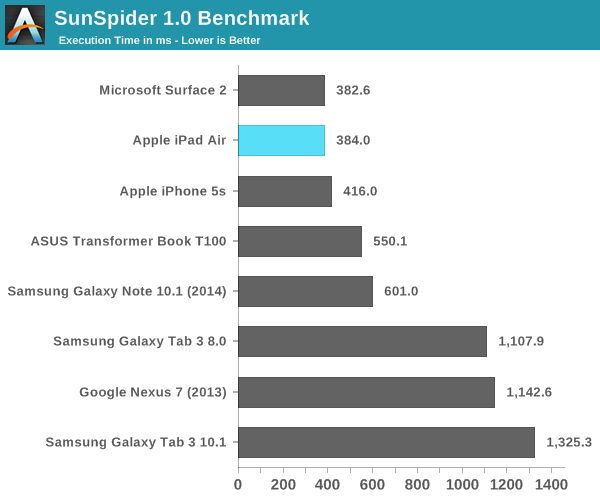
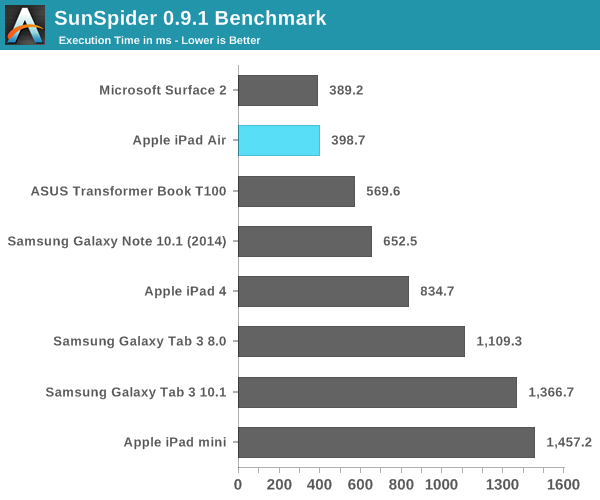
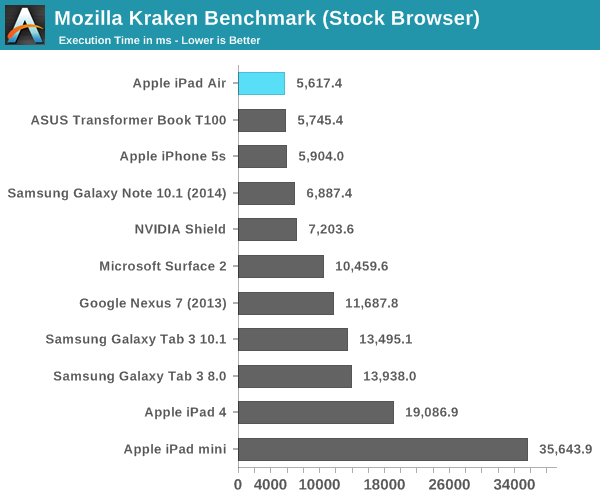
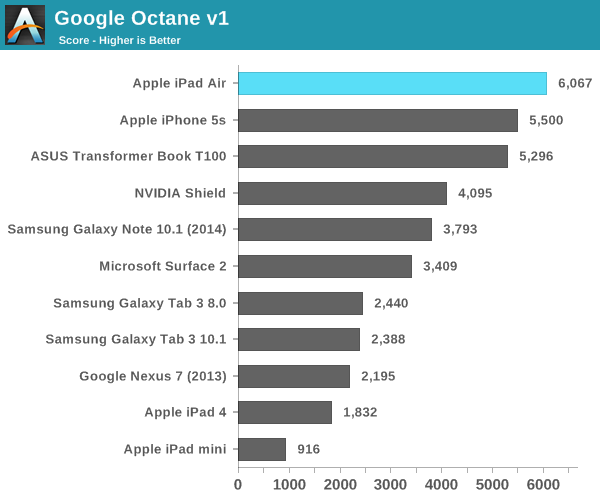
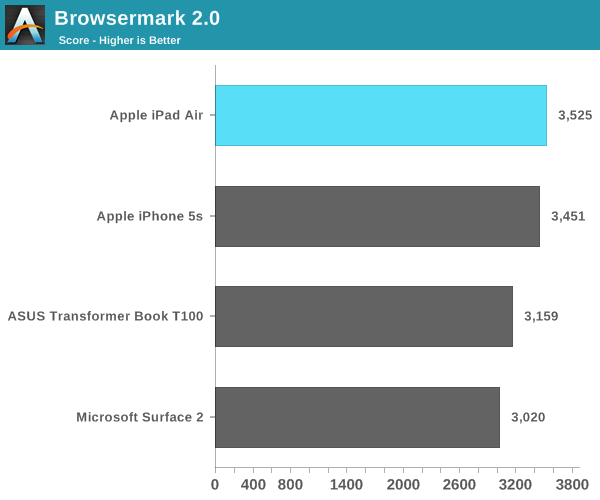

A7 Power Consumption
I’ll get to battery life in a bit, but I’ve been curious about the dynamic range of power consumption offered by Apple’s new A7 SoC. On the one hand we’re dealing with a lower power process (28nm vs. 32nm), but on the other hand Apple’s Cyclone cores can clearly draw more power given how beefy the architecture is this round. Apple frowns upon review sample dissection so I had to turn to a less scientific method of external platform level power measurement. The fidelity of the numbers here aren’t all that great but it’s better than nothing.
For the first test I measured platform power consumption during a Kraken run:
I purposely started measuring before the benchmark so I could get an idea of idle power consumption. The iPad Air consumes roughly 72% of the idle power as the iPad 4, both running at the same brightness. Here we’re not just seeing the A7’s advantages but also things like lower display power.
Focusing on the load portion of the measurement we see that both the new iPad and old iPad consume the same total power in this test. I suspect the A7 is drawing more power than the A6X, but it’s masked by a lower power display. Given how much faster the iPad Air is, Apple’s latest tablet features far lower overall task energy than the outgoing iPad 4. This is probably both the best case scenario for the iPad Air and the most likely case as well.
For kicks I wanted to see just how much power I could get the iPad Air to draw. Here I’m looking at platform power during our mini-power-virus test from above:
How’s that for dynamic range? Almost 12W running all out, but around half that in what we’d normally consider to be a stressful CPU test. I couldn’t get any actual applications/games on the iPad Air to behave like this so the results above are purely academic (for now). A quick run through GFXBench 2.7’s T-Rex HD test confirms that even pushing the GPU won’t hit these numbers. The max I saw running T-Rex offscreen was ~6W, and turning to an actual game (Infinity Blade 3) the iPad Air pulls less than 5W.


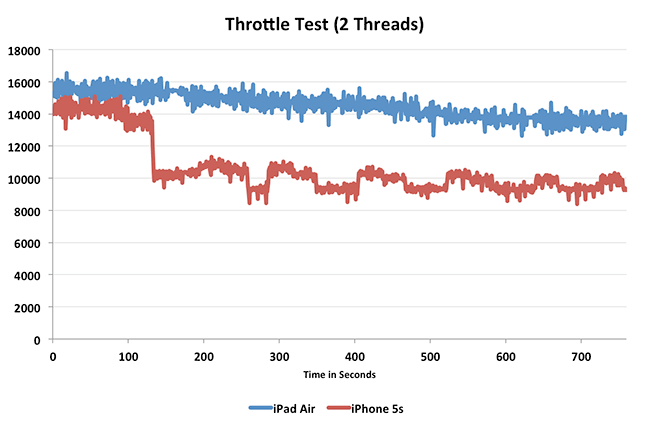
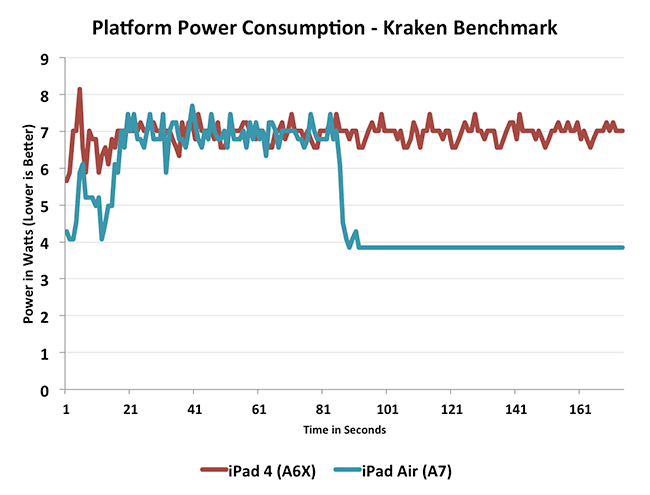
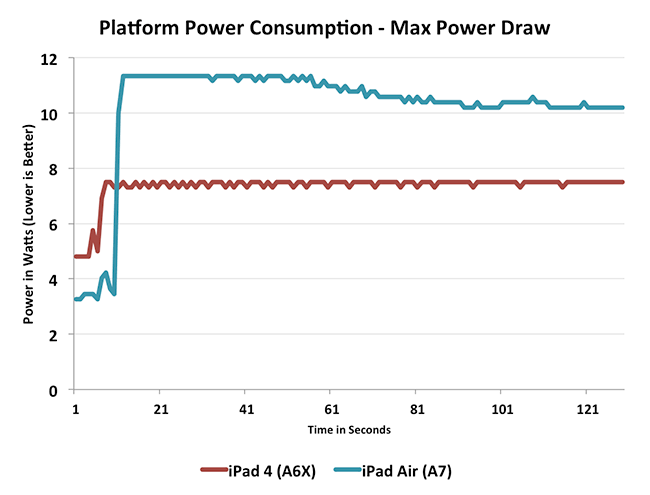








444 Comments
View All Comments
Wilco1 - Thursday, October 31, 2013 - link
Typically you run benchmarks at the maximum performance so you can compare different devices at known frequencies. A long running benchmark will always run at the maximum frequency - as long as there is no thermal throttling. So DVFS only has an effect on benchmarks which run for very short times (milliseconds like SunSpider, AnTuTu etc). This means the results are random based on the DVFS settings (hardware/software) and what you did just before starting the benchmark. That makes it hard to make fair comparisons. So setting the frequency before running a benchmark makes the results more useful.If you want to benchmark the DVFS then you need something more specific - I'm not aware of benchmarks which accurately try to measure DVFS, it's reaction speed, the power/performance tradeoff and effect on GUI interaction. The closest one is Anand's battery-life test which has idle periods followed by high activity bursts. Unfortunately he doesn't list performance of this test, only battery-life...
rynite - Friday, November 1, 2013 - link
"Typically you run benchmarks at the maximum performance so you can compare different devices at known frequencies."Oh please. Who decides how a benchmark is run? You? Or the actual benchmark authors like Anand and Futuremark, who publicly oppose this sort of behavior?
Wilco1 - Sunday, November 3, 2013 - link
Anand doesn't have a clue unfortunately. If INtel's turbo is not cheating then it is certainly not cheating to use the maximum frequency.Gondalf - Saturday, November 2, 2013 - link
Hei Wilco. IPC apart....without a SPEC submission it's hard to give a final judgment, what about A7 is only dualcore??? Anand says that A7 is the best around, but it's an absurdity !! In a multitasking workload A7 is clearly doomed by Snapdragon, Tegra, Baytrail. IMO this review is biased, A7 is good yes but only in light multithread, very bad in a serious usage, and looking at the selling price a customer is only a victim of Apple MarketingWilco1 - Sunday, November 3, 2013 - link
Yes, in terms of throughput A7 would be slower than most of the quad cores, however having the fastest single threaded performance is equally important.someonethinks - Wednesday, October 30, 2013 - link
iPad Air2 pleaseApple does it again, it will sell but device is not quite as good as it should be, do they care about the users or just the profit?
I would like
2GB and 32GB min
smooth transitions that can also be turned off / reduced
I have an iPad 2 and was looking to replace but the memory is really a big issue to future proof it, so I am VERY disappointed as I don't buy something like this every year.
With the original, I waited for the iPad 2 and was very pleased, it looks like I need to do the same again or maybe I now just go elsewhere.
xype - Wednesday, October 30, 2013 - link
Ooooor you could assume that the iPad Air is actually good enough. Because it is. Go and try it with some apps at a store and then decide; the whole making assumptions based on articles is not really helpful. Compared to an iPad 2, the iPad Air will absolutely blow you away.aliasfox - Wednesday, October 30, 2013 - link
Good enough? Yes. But for my money, "good enough" in 2013-2014 isn't enough - I want my devices to be "good enough" for a long time, especially at $500+. I kept my laptop for eight years, my previous digital camera lasted eight years, the shortest I've kept a cell phone is three and a half years, and my current desktop is seven years old with just a GPU and storage upograde (granted, that was a high end machine when it came out).Buying a device that has deficiencies *now* is questionable if you want to keep it for a while.
And don't think this is coming from a PC fanboy, either. iPad 1, iPhone 4, and Mac Pro are my primary devices.
KPOM - Wednesday, October 30, 2013 - link
By that logic, though, any Android device today has "questionable" specs since undoubtedly in a year or so most high-end Androids will have 64-bit processors. The iPad AIr, new iPad mini and iPhone 5s already have them.I think, also, that since all 3 have the same internals, we'll see developers write to those specs. I.e. lack of RAM won't be a significant issue because it isn't as if developers will be writing for devices with significantly more RAM.
suman0011 - Wednesday, October 30, 2013 - link
At every one knows apple has the leading market share in the android phones but now a days companies like Samsung are exploring the market at present Samsung has the major share in the android phone segment if i am right.in order to that apple has to found news to gain their place in the android marketas in most of the people use android phones that to Samsung phones
here you can find a link why Samsung why Samsung is in 1st place
http://indiahomedepot.com/samsung-galaxy-tab-t-211...
just look at only the specification and you can compare with apple ipad
of course all the features available in the apple also available in the Samsung can some tell why Samsung is first and Apple is trying hard to get first place?